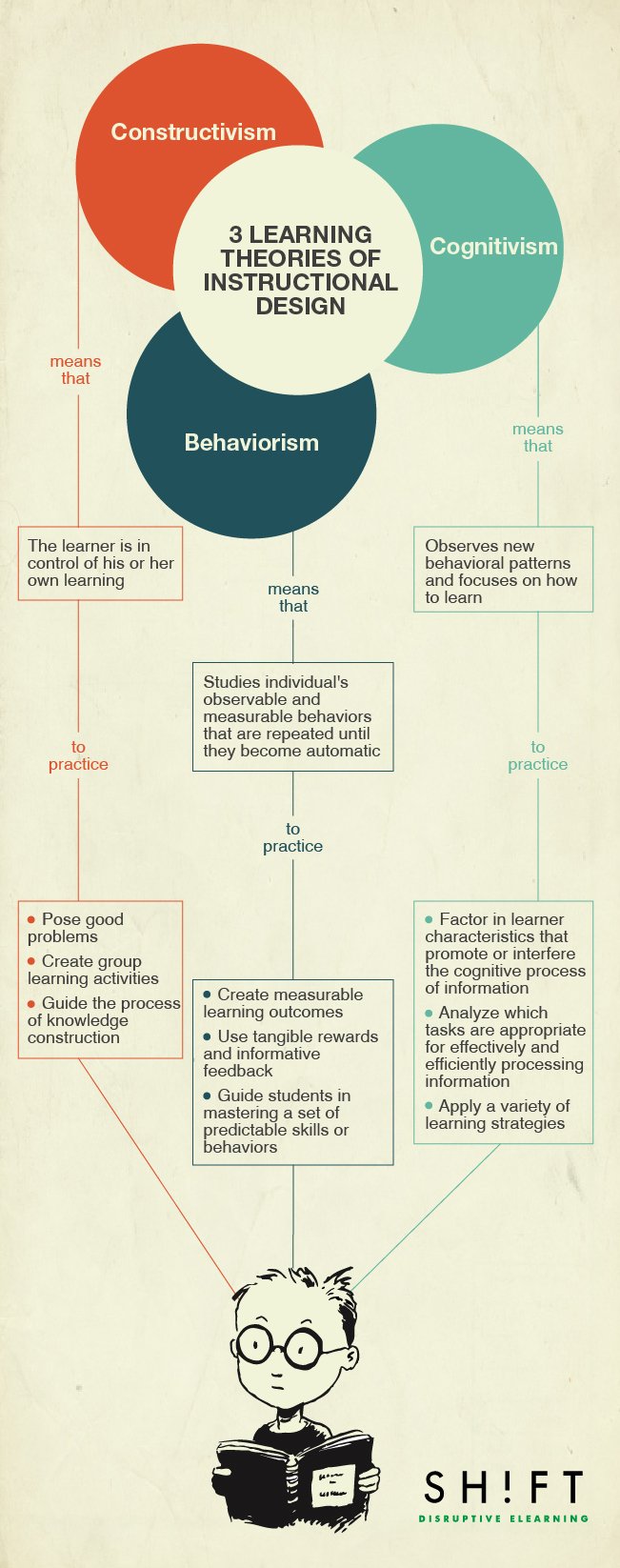A lot of eLearning professionals, especially those who have just started with their practice, often ask about the need for theory. Why bother with an instructional design theory at all? Isn't practice enough?
Practice and theory actually goes hand in hand. This is true not only in instructional design but in any other field or discipline. Theory, far from crippling your practice, will actually help you improve the quality of your eLearning material. While a learning theory won't answer all of your design problems, it offers clarity throughout your process and directs you toward finding solutions.
Three Most Popular Learning Theories of Instructional Design
Of the many eLearning theories that influence the practice, three of them are used by professionals on a daily basis. And all of them are concerned with HOW students are going to learn. By understanding each of them, you are able to figure out which works well in a learning environment. You can, of course, combine these theories depending on your (1) goal as an instructional designer, (2) the business objectives of your organization or client organization, (3) the needs of learners, and (4) the subject matter.

This theory focuses on an individual's observable and measurable behaviors that are repeated until they become automatic. It also deals with how an individual's external environment shapes his or her behavior.
Since the theory is only interested in quantitatively observing responses to stimuli, it totally ignores the possibility of thought processes inside a learner's mind. It's only concerned with "what" learners need to know—which explains the behaviorist's use of methods such as identification, rote memorization and association.
In skill building, the same behaviorist approach is applied by observing (what) a particular skill and practicing it. The student's task is to remember the skill and respond, while the instructor offers feedback (indicate whether the response is correct and incorrect) and provide for practice.
Behaviorism is deemed applicable to instructional design when you aim:
- To create measurable and observable learning outcomes among students
- To use tangible rewards and informative feedback to improve student learning performance
- To guide students in mastering a set of predictable skills or behaviors
Like Behaviorism, Cognitivism observes new behavioral patterns. But Cognitivism focuses on what Behaviorism ignores—the thought process behind the behavior. Having observed changes in the behavior, adherents of this theory then use those changes as indicators to what's happening inside the individuals' mind.
Learning, from a Cognitive point of view, then, is more of an internal and active mental process. And unlike Behaviorism (which focuses on the what), Cognitivism focuses on the how—how to learn. While Behaviorism draws attention to the learner's environment, Cognitivism offers a learner-focused approach. It uses tools and technology that mimics the human thought process and even considers more complex processes such as problem-solving, thinking, information processing and concept formation.
This is not to assume that Cognitivism is better than Behaviorism. Again, the right theory will depend on factors enumerated earlier. If you decide to take a cognitive approach to designing your material, be sure to:
- Factor in learner characteristics that may either promote or interfere with the cognitive process of information
- Consider and analyze which tasks are appropriate for effectively and efficiently processing information
- Apply a variety of learning strategies that allow learners to connect new information to prior knowledge.
This theory posits that we perceive a distinct image of the world based on our individual experiences, mental structures and beliefs. Similar to Cognitivism, it places the learner at the center of the learning environment. The learner isn't merely absorbing information passively but is actively involved in constructing knowledge individually. This means knowledge cannot be simply transmitted from one learner to another.
From a Constructivist's point of view, the learner is in control of his or her own learning. That's why it's important to make information accessible and available in several ways so that learners can revisit content anytime and manipulate information based on their goals.
Further Read: Guiding principles of constructivist thinking
Now that you are able to distinguish three basic instructional design theories, how do you decide which one to use?
While there's no single formula for selecting the most appropriate theory, experts usually match learning theories with the learning content.
For instance, the behavioral approach is much more effective in helping learners master the content of his or her profession (knowing what) and where learner bring almost none prior knowledge to learning.
On the other hand, the cognitive approach can effectively help learners solve problems in unfamiliar situations (knowing how) as this theory is usually considered more appropriate for explaining complex forms of learning (reasoning, problem solving, etc).
As for the constructivist approach, experts have effectively applied it when dealing with ill-defined problems that calls for reflection-in-action.(Ertmer P. & Newby, T., 1993)
Quick Reads:Buy the Learning Theories in Plain English eBook Vol. 1
All about: Behaviorism, cognitivism, constructivism: comparing critical features from an instructional design perspective (Ertmer & Newby 1993)